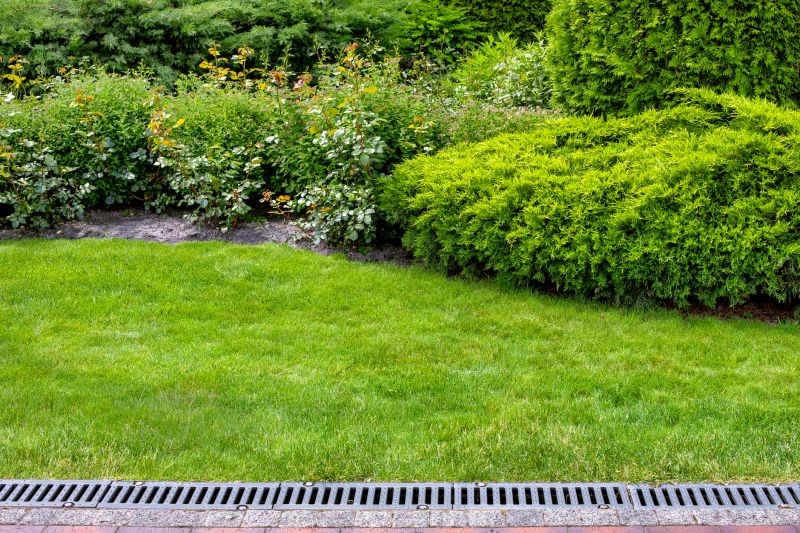Leading Yard Drainage Products For Seamless Water Management
Explore top-rated drainage options designed to keep your yard dry and prevent water buildup after heavy rains.
 Effective yard drainage solutions are essential for managing excess water and preventing damage to landscaping, foundations, and outdoor structures. Proper drainage helps mitigate issues such as soil erosion, pooling water, and standing moisture that can lead to plant health problems or structural concerns. When selecting products for yard drainage, it is important to consider the specific needs of your landscape, the severity of drainage issues, and the type of soil and terrain involved.
Effective yard drainage solutions are essential for managing excess water and preventing damage to landscaping, foundations, and outdoor structures. Proper drainage helps mitigate issues such as soil erosion, pooling water, and standing moisture that can lead to plant health problems or structural concerns. When selecting products for yard drainage, it is important to consider the specific needs of your landscape, the severity of drainage issues, and the type of soil and terrain involved.
Top Overall Option
Versatile Drainage Pipe System
A comprehensive drainage pipe system designed for flexible installation in various yard conditions. It features durable perforated pipes, connectors, and gravel beds that facilitate efficient water movement and prevent pooling. Ideal for both surface and subsurface drainage needs, this system can be customized to fit different yard layouts and water management requirements.
Types of Products For Yard Drainages
Perforated Drain Pipes
Flexible or rigid pipes with perforations that allow water to enter and be directed away from problem areas.
French Drains
A trench filled with gravel and a perforated pipe to channel water away from foundations and low-lying areas.
Drainage Gravel and Stone
Specialized gravel and crushed stone used to improve water flow and filtration in drainage systems.
Drainage Mats and Panels
Plastic or rubber mats that facilitate water movement and protect underlying soil or structures.
Surface Drainage Channels
Channels or troughs designed to direct surface water runoff away from yard areas.
Catch Basins and Grates
In-ground units that collect surface water and connect to underground drainage pipes.
Swales and Ditches
Shaped depressions or channels that guide water flow across the landscape.
Dry Wells
Underground chambers that allow water to percolate into the soil gradually.
Waterproof Membranes
Membranes used to prevent water intrusion in basements and foundation walls.
Soil Aeration Products
Tools and products that improve soil permeability and drainage capacity.
Drainage Sleeves and Wraps
Protective coverings for pipes that prevent clogging and facilitate water flow.
Rain Barrels and Water Harvesting Systems
Containers to collect rainwater, reducing runoff and aiding in yard management.
Popular Choices
Widely used for various drainage applications, these pipes are easy to install and adapt to different yard configurations.
Complete kits that include pipes, gravel, and fittings for DIY installation of effective drainage solutions.
Popular for filling trenches and around pipes to enhance water flow and filtration.
Channels designed to quickly direct runoff away from yard surfaces, reducing pooling.
Effective for collecting surface water and preventing debris from clogging underground pipes.
Used around foundations and retaining walls to promote water movement and prevent moisture buildup.
Popular for managing excess water in low-lying areas by allowing it to percolate into the ground.
Commonly used in basement waterproofing to divert water away from foundations.
Tools that help improve soil drainage, especially in compacted areas.
Popular for collecting rainwater, which can help reduce runoff and provide irrigation options.
Different drainage products serve various functions, from redirecting water flow to absorbing excess moisture. Installing the right combination of drainage solutions can significantly improve yard safety and usability. For example, surface drainage options like swales and channels are effective for directing water away from problem areas, while subsurface solutions such as perforated pipes and French drains work beneath the surface to remove excess water efficiently.
Assessing your yard’s drainage challenges involves understanding the landscape’s slope, soil permeability, and existing water flow patterns. Proper planning ensures that the selected products integrate seamlessly into your yard, providing long-term relief from water accumulation issues. Regular maintenance and inspection of drainage systems are also crucial to ensure they function optimally over time.
Investing in quality drainage products can help protect your property and improve outdoor space usability. Whether you are addressing a small puddling problem or managing larger water runoff issues, the right products can make a significant difference. Remember, consulting with drainage specialists or landscapers can provide tailored recommendations suited to your yard’s unique conditions.
Key Buying Considerations
- Assess the severity and source of drainage issues to select appropriate products.
- Determine whether surface or subsurface drainage solutions are needed based on the problem area.
- Evaluate the soil type and permeability to choose compatible drainage materials.
- Consider the yard’s slope and landscape layout to plan effective water flow paths.
- Check the durability and material quality of pipes and fittings for long-term performance.
- Ensure compatibility of components if combining different drainage products.
- Think about ease of installation, especially if planning a DIY project.
- Review the maintenance requirements of the drainage system to ensure longevity.
- Estimate the size and capacity needed to handle expected water volume.
- Identify areas where water pooling or erosion occurs most frequently.
- Plan for access points like catch basins or cleanouts for easy inspection and cleaning.
- Consider aesthetics if visible drainage features are part of landscape design.
- Budget for additional materials such as gravel, geotextiles, or landscaping fabric.
- Consult with professionals if unsure about the best approach for complex drainage issues.
- Verify local building codes or regulations related to drainage installations.
